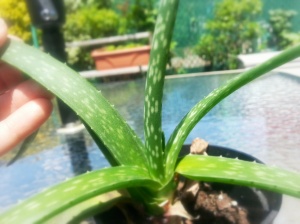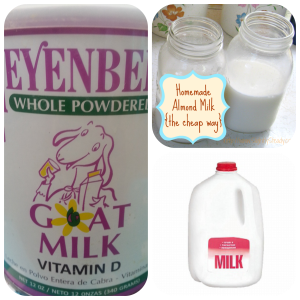
A few months ago, I did a post about how to pick oils for your homemade lotion. If you’re interested, you can check it out here. It was a popular post all about the oil phase of a lotion. In this post, I will talk mainly about picking good liquids for the water phase.
The water phase of recipes is sometimes overlooked. We often focus heavily on which kinds of oils and butters to use. Let me tell you a little secret though: a lot of these oils and butters that are popular and expensive are overrated. I have bought my fair share of fats du jour – babassu oil, argan oil, tamanu oil, meadowfoam seed oil, cupuaçu butter, to name a few. Some of them are amazing. Most of the time, though, you can’t even tell the difference. I usually use the same oils and butters that I love and have come to depend on, mostly because they are well-priced and get the job done. Sometimes, I splurge and have a little fun but one of the reasons I started making lotion at home was to save money so I don’t want to get too caught up in trends.
In many lotion recipes, the liquid of choice is distilled water. It’s preferred over tap water, not because of cleanliness, but because distilled water does not have any solutes – nothing is dissolved in it, it’s pure water. Tap water usually contains chlorine, fluoride, minerals, and other substances so most lotion makers prefer distilled. Distilled water is very inexpensive and can be found at any store. It’s also kind of boring. There are a zillion other liquids you could choose. Here are some.
Aloe Vera
Aloe is…it’s just the best. Is it any surprise that this is first on the list? It’s good for so many skin ailments. Sometimes, when a burn needs soothing or skin is crying out for hydration, I will snip a piece of squeeze it directly from the leaf.
Sadly, you probably won’t have much success if you try to use it straight from the plant in your recipes. Instead, you should use aloe vera liquid. This isn’t the same as aloe vera gel that is sold in stores as a sunburn soother. I get my aloe vera liquid from Brambleberry. You can use aloe vera liquid in lieu of water. You don’t need to make any adjustments. Your skin will be hydrated and soothed.
Colloidal Oatmeal Tea
Colloidal oatmeal is miraculous stuff. It’s just oat flour. Oat flour can be made at home easily.
1. Get your oats.
2. Grind to a powder in a spice/coffee grinder. Fin
But you can’t just dump oat flour into your lotion. You need to make tea. Easy peasy. Click here to see my post on how to make it.
I recommend using a mixture of colloidal oatmeal and another, thinner liquid. Colloidal oatmeal is more viscous than water or aloe vera liquid and could make your lotion thicker than you want. If you want a thick & creamy emulsion, you can use colloidal oatmeal only in your water phase. If you want something a little lighter, replace only half of the water phase with colloidal oatmeal. It does wonders for itchy skin. It’s terrific on dry skin. Even stubborn eczema symptoms can be relieved using colloidal oatmeal.
Tea
Just steep the tea in hot distilled water and use in place of water. I like to make the tea twice as strong as I would like to drink it. Chamomile tea is a lovely choice. So is calendula. Combine them with lavender essential oil for a soothing, ultra-relaxing concoction. When substituting tea for water, there is no need to change the ratio. Occasionally, I will use green tea in a spritz, toner, or cleanser. Not all herbs are good choices so pick wisely and do your research.
Milk
If you’re going to use milk in your recipes, you have to keep a few things in mind. Firstly, I don’t recommend milk for beginners. You need to be extra careful and diligent about sanitation. Milk lotions are more prone to spoiling. Only use pasteurized milk. Don’t use milk products that contain live cultures. If you want to use yogurt or buttermilk, which are great for skin, check to make sure it doesn’t contain live cultures or heat it up enough to kill the bacteria.
Goat milk is very popular for lotions. Goat milk lotion will be rich yet light. Even regular whole cow’s milk would be nice. Another choice is almond milk. Keep in mind that milks have a high fat content. If you replace all the water in a recipe with milk, you may end up with a thicker or greasier lotion than you want. Feel free to dilute milk with distilled water for a lighter finished product.
Hydrosols
Hydrosols are a favorite addiction additive of mine. Rosewater is probably the most well-known one but there are many including chamomile, calendula, cucumber, lavender, lemon verbena and many, many more. Besides the fact that they usually smell divine, they also add to your formulation in the same way an essential oil would. Because they’re often highly concentrated, they can be pricy but you can use them sparingly. Replace 5-20% of your water with a hydrosol instead of replacing all the water to save money but still reap the benefits.
Silk Amino Acids
Silk amino acids add a smooth, silky feeling to products. Most of the time, you only need to use it about 2% concentration to see effects. They are great for light, summery lotions.
Hope you enjoyed this post. As usual, if there are any questions, email hippiebrowngirl@gmail.com





I’m so glad you posted this! I’ve been wanting to experiment with the water phase, and planned to play around when I got home from work today, so the timing is spectacular! Your site is 100% my favorite for natural beauty products because of the science you include. You don’t tell me “this thing is the best,” you tell me, “This works this way and this works another way” and I really appreciate that information as it is surprisingly hard to find. I got into natural beauty products because they are so customizable and just a recipe isn’t always the information I am looking for. So thank you so much!
Wow! Thank you so much for this awesome compliment and thanks for reading. I really appreciate it!
Thank you so much for this post.. I am beginner and I am using Aloe Vera gel and water in most of my recipes. I would love to try tea and oatmeal tea.. Going to try it soon.. Thanks again.. 🙂
Let me know how it goes! 🙂